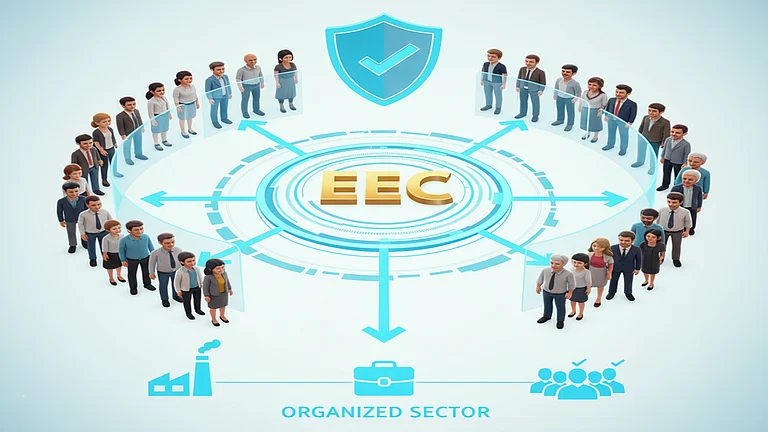Over half of EPFO members end up with less than Rs 20,000 in their account at the time of final settlement, according to a media report.
Around 95% of final settlements are premature withdrawals after brief unemployment, with nearly half of those members rejoining the EPFO later.
The new EPFO rules aim to simplify withdrawals and protect long-term savings by requiring members to retain 25% of their balance.
The Labour Ministry clarified that 75% of funds can still be withdrawn immediately upon job loss, addressing concerns raised by workers and political leaders.
Withdrawals Are Draining Employees’ Retirement Corpus, EPFO Data Shows: Report
Frequent withdrawals are leaving EPFO members with little to retire on. A recent report analysis reveals half of all members have less than Rs 20,000 at settlement. The EPFO’s new 25% minimum balance rule aims to fix that, but it’s not without controversy
The Employees’ Provident Fund Organisation (EPFO) was created to provide a financial cushion for India’s workforce in old age. However, a recent analysis of official data, reported by The Indian Express, shows that the retirement corpus for most workers is being steadily eroded, often by their own hands.
The data shows that nearly half of EPFO members have less than Rs 20,000 in their accounts when they make their final withdrawal. About 75 per cent have less than Rs 50,000, and 87 per cent have less than Rs 1 lakh.
The primary reason: frequent and premature withdrawals. Around 95 per cent of final settlement claims in 2024-25 were made shortly after members reported unemployment, even though 46 per cent of them later rejoined EPFO-registered employers.
This cycle of exit and re-entry, as a senior official pointed out to The Indian Express, has long-term costs. It breaks the continuity of provident fund membership, eroding pension eligibility and reducing the eventual corpus. “These breaks are detrimental to members’ interests and can deprive them of family pension or lower their pension amount at retirement,” the EPFO noted in its board agenda.
A Shrinking Corpus for the Working Class
EPFO data underlines the financial vulnerability of India’s formal workforce. Over 65 per cent of members earn Rs 15,000 or less a month, the wage ceiling for mandatory EPF contributions.
That means the majority belong to the lower-income segment, for whom the provident fund is often the only form of long-term saving.
Partial withdrawals have also been rising steadily, particularly after the Covid-19 pandemic. In 2024-25 alone, 3.25 crore claims worth Rs 52,634 crore were settled under the “illness” category, showing a 55 per cent jump from the previous year.
Housing-related claims, too, grew by nearly 30 per cent, while withdrawals for “special circumstances” touched a seven-year high.
Officials said the removal of documentation requirements and auto-processing of claims since 2017 has made withdrawals easier but also more frequent. In some cases, members have used the “illness” advance up to four times in a few years.
EPFO’s Intervention: A Minimum Balance Rule
Alarmed by the steady depletion of balances, the EPFO recently streamlined its 13 withdrawal categories into three, namely, essential needs (illness, education, marriage), housing needs, and special circumstances, while introducing a mandatory 25 per cent minimum balance in members’ accounts.
The Labour Ministry, in an official clarification recently, said the decision was based on recommendations from the EPFO’s Finance and Audit Committee and approved by the Central Board of Trustees after consultation with employer and employee representatives.
“The idea is to balance flexibility with security,” the Ministry said, adding that members can now withdraw up to 75 per cent of their funds, including both employer and employee contributions, immediately upon job loss. The remaining 25 per cent can be withdrawn after one year of unemployment, or fully at retirement, disability, retrenchment, or permanent migration.
Officials defended the move as necessary for long-term financial health. “People don’t withdraw unless there is a need, but repeated withdrawals mean smaller pension benefits later. Every provident fund member should be a pensioner too,” a senior EPFO official told The Indian Express.
Political and Worker Concerns
The new rules sparked protests from some opposition leaders and workers’ groups, who feared that restricting immediate access could hurt lower-income employees. AIMIM chief Asaduddin Owaisi also posted on X, questioning whether workers were being deprived of their own savings. He said:
“Is the money EPFO’s or the member’s? These people are not beneficiaries of freebies but hardworking citizens who are being deprived of their own savings.”
The Labour Ministry later clarified that the changes do not restrict withdrawals but aim to ensure that workers don’t end up retiring with negligible savings. The EPFO data, it said, shows that half of members retire with balances too low to provide meaningful support, primarily because of frequent early withdrawals and short tenures.
A Structural Problem
However, the retirement fund body’s dilemma goes beyond individual financial decisions. The data, perhaps, highlights a larger issue of informal job churn, low wages, and lack of financial literacy among the workers.
Many EPF members might even be treating their provident fund amount as an emergency fund rather than a retirement safety net. By introducing the 25 per cent minimum balance rule and simplifying the withdrawal procedures, the EPFO has tried to curb such tendencies.
However, whether the measure will work in an economy marked by job insecurity and periodic unemployment remains to be seen.
As the official said, “We have to start thinking about the ageing population, which will increasingly depend on their own contributions.”



